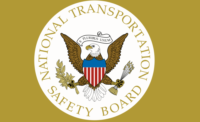The probable cause of the crash of a business jet in a Boston suburb last May was a series of errors by an experienced flight crew, the National Transportation Safety Board (NTSB) said at a public meeting this week. Specifically, the pilots failed to perform a flight control check before takeoff then attempted to take off while critical flight controls were locked because a gust lock was engaged. Finally, they delayed rejecting the take-off after they became aware the flight controls were locked.
Complacency in the cockpit
“This investigation highlights the importance of following standard operating procedures and underscores the significance of procedural compliance,” said NTSB Vice Chairman Bella Dinh-Zarr. “Complacency does not have a place in the cockpit of any aircraft.”
At 9:40 pm EDT on May 31, 2014, a Gulfstream G-IV business jet bound for Atlantic City crashed after it overran the end of runway 11 during a rejected takeoff at Laurence G. Hanscom Field in Bedford, Massachusetts. The airplane rolled through the paved overrun area; continued across a grassy area, striking approach lights and an antenna; and traveled through the airport fence before coming to rest in a ravine. A postcrash fire engulfed the airplane almost immediately. Everyone aboard – two pilots, a flight attendant and four passengers – were killed.
During the engine start process, the flight crew failed to disengage the airplane’s gust lock system, which locks the primary flight control surfaces while the plane is parked to protect them against wind gusts.
Habitual noncompliance
The flight data recorder and cockpit voice recorder indicated that neither of the two flight crewmembers, who had flown together for about 12 years, had performed a basic flight control check that would have alerted them to the locked flight controls. A review of the flight crew’s previous 175 flights revealed that the pilots had performed complete preflight control checks on only two of them. The flight crew’s habitual noncompliance with checklists was a contributing factor to the accident.
“This investigation raises troubling questions about how a long-term pattern of noncompliance was allowed to develop for this very experienced flight crew,” Dinh-Zarr said. “More importantly, our investigation asks whether this is a prevalent practice in the business aviation community, and how we can prevent these accidents from happening again.”
11 seconds that made the difference
About 26 seconds into the takeoff roll, when the airplane had reached a speed of 148 mph (129 kts), the pilot in command indicated that the flight controls were locked, but the crew did not begin to apply the brakes for another 10 seconds and did not reduce engine power until four more seconds had passed. The NTSB determined that if the crew had rejected the takeoff within 11 seconds of the pilot’s comment, the airplane would have stopped on the paved surface and the accident would have been avoided.
The G-IV gust lock system design was intended to limit the operation of the throttles when the system was engaged so that the flight crew would have an unmistakable warning that the gust lock was on should the crew attempt to take off. However, the investigation revealed that Gulfstream did not ensure that the gust lock system would sufficiently limit the throttle movement on the G-IV airplane, which allowed the pilots of the accident flight to accelerate the airplane to takeoff speed before they discovered that the flight controls were locked.
FAA criticised, too
The NTSB said that the Federal Aviation Administration’s certification of the gust lock system was inadequate because it did not require Gulfstream to perform any engineering certification tests or analysis of the G-IV gust lock system to verify that the system had met its regulatory requirements.
Also contributing to the accident were Gulfstream’s failure to ensure that the gust lock system would prevent an attempted takeoff with the gust lock engaged and the FAA’s failure to detect this inadequacy during the G-IV’s certification.
As a result of the investigation, the NTSB issued a total of five safety recommendations to the FAA, the International Business Aviation Council and the National Business Aviation Association.
In addition, the NTSB developed a Safety Alert for all pilots on the importance of following standard operating procedures and using checklists to guard against procedural errors.
Las Vegas airplane fire
It’s been a busy week for the NTSB. In addition to releasing the Massachusetts accident findings, the agency sent a go-team of investigators to Las Vegas to investigate the engine fire on a British Airways 777 that occurred on Tuesday.
The team is being led by Senior Investigator-in-Charge Lorenda Ward and includes engine, systems and fire specialists. She may request other investigators as needed during the course of the investigation.
The airplane, bound for London, aborted its takeoff.






